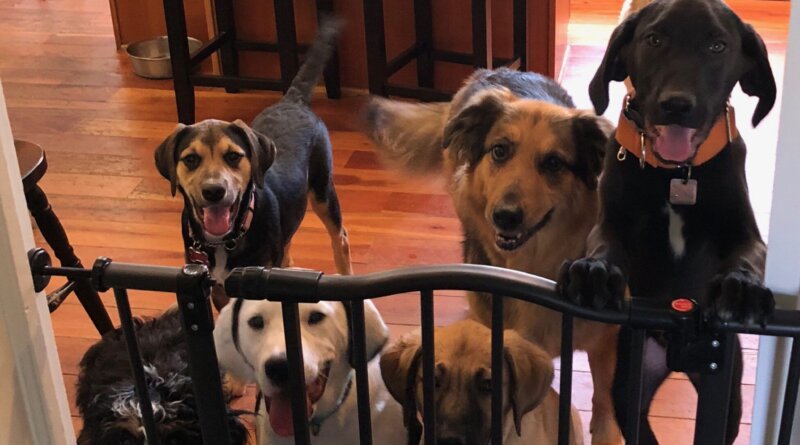Types of Dog Gates – Whole Dog Journal
There is no end to the useful applications for dog gates – and today, there’s no end to the sizes, types, and designs of dog gates that are available. It’s so easy to use them to help you and your dog live more happily together; the most difficult part might be choosing which ones look best in your home.
Here are the main types of gates available and what applications they are best for:
Pressure-Mounted Gates, Tall dog Gates, Gates With Small Pet Doors
These gates are probably the kind that most dog owners are familiar with. Most have rubbery casters on both end that will hold the ends of the gate against both sides of a doorway, and some sort of mechanism that expands and contracts the width of the gate to make it fit tightly in the doorway.

There are multiple models with some sort of bar that lifts to cause the gate to contract in width and is lowered to expand and lock the gate at the desired width. These can work well, but they take longer than most gates to open and close the again; most people with these gates end up stepping over them, in order to avoid having to adjust their width each time. Or, they stop adjusting the width but just set them at one width and force them in and out of position as needed (the trouble is, if they can be pushed out of place that easily, your dog may quickly learn to do that, too. These gates generally come in standard door widths only, though they may come in several heights. They are most commonly found in big-box stores such as Wal-Mart and may be marketed for babies and pets. We don’t recommend them! (See “Gates We Do Not Recommend,” below.)
Far better are the models that are made specifically as pet gates and have easy-to-open and -close openings. These generally have a bar that spans the doorway at the bottom, which maintains the stability of the gate when it’s opened and closed. Many companies offer extensions of various widths for these gates that are sold separately.

My favorite model, the MidWest Steel Pet Gate, has four discreet little rubber discs that mount to the door frame with sticky tape (for extra security, each can also be fastened to the door frame with a single wood screw). When the gate is not in use, I remove the gate altogether; the discs stay in place. When I’m hosting puppies, I just pop the gate ends back into the discs and expand/tighten the gate with its tension knobs.
A similar model is Carlson Pet Products’ Extra Tall Walk-Thru Gate with Pet Door. This gate mounts and is adjusted in the same way as the MidWest gate, but has a small, cat-sized (8-inch square) doorway built into the gate. As long as your dog is larger than a cat, with the gate closed and the cat door open, your cat can come and go (or escape your dog, if need be) while your dog is securely contained behind the gate.
Folks with open-plan homes may have a hard time finding a good spot for a pressure-mounted gate, but don’t forget that a stairway, bathroom, or bedroom can work.
Hardware-Mounted Dog Gates: Best for Stairs

These are the sturdiest choice, because they are secured tightly to the door frame. These are often the best choice for permanent (or at least, years-long) installations – as opposed to something you will use just for visting dogs or for the period of time that it takes to house-train your new puppy. Many of them are made by the same companies that make pressure-mounted gates and they may closely resemble those products, but fasten to the door frame with wood screws. These also lack the floor-level bar that maintains the integrity of the pressure-mounted gates; when you open the gate, there is nothing to step over.
For safety at the top of stairs, nothing can beat a well-installed, hardware-mounted gate. Period.
The long-time favorite hardware-mounted gate of WDJ editor Nancy Kerns is the KidCo Wall-Mounted Pet Gate. She bought one for a WDJ review of gates in the late 1990s that is still being used in an outdoor application (blocking a side entrance to a deck) at her sister’s house today!
Stand-Alone Dog Gates, Gates for Extra-Wide Spaces
As you might infer, stand-alone gates have some kind of footing structure at each end so that they can stand alone. These gates tend to be a little heavier (so they aren’t easily pushed out of the way by your dog) and bulkier to store, and the feet can actually interfere with positioning them in some spots, but they can be the perfect solution to open-plan home designs with few doorways. They’re available in everything from a bargain utilitarian white metal to very high-end wood and wrought iron pieces designed to make you not mind having to have them in place.

To pass through the ones meant for smaller openings, you generally just drag or slide one end to the side and replace it behind you. The longer ones that span wider openings usually have a hinged gate built into one panel, such as the Kinpaw Freestanding Foldable Pet Gate. Some, like that gate, are made with hinges connecting each section, so they can be folded for storage, or to fit variously shaped openings (great for the foot of stairways that are wide or irregularly shaped). Others are built straight, like Carlson’s Extra-Tall Adjustable Freestanding Pet Gate or Richell Wood Freestanding Pet Gate (note that this one is very low, only 20 inches high).
This kind of gate can turn that space between the back of your couch and the wall into a perfect little dog confinement area! Position two of them end-to-end and you’ve separated the dining table from the family room so you can host that dinner party without totally excluding the dog.
People dismiss these because they think “Oh, that would never hold Rufus.” And yes, that gate might not work during a long boring day when Rufus is alone. But that stand-up gate is your friend for the quick pizza delivery, or neighbor drop-in, or the not-yet-potty-trained puppy visiting for an hour who you’d like to confine to the kitchen. Keep it stashed behind the couch, and pop it up when you know somebody’s due in a few minutes.
The Multi-Purpose X-Pen

Few things in dog life are as reliable, flexible, and life-saving as the common wire exercise pen, a.k.a. the x-pen! These are typically made with eight panels that are joined with little metal sleeves that allow them to flex in any direction. Attach the first panel to the last panel with acouple of metal snaps or carabiners to make a round, square, or rectangular pen, or stretch the panels out to create a door blocker or a room separator. These pens are relatively light and easy to move, which means you have to use some creativity to prevent them from being pushed around by a dog who is determined to move them. But if we’re talking about a quick 30 seconds while you answer the door, the x-pen standing up in a V or W shape can block a key doorway. Exercise pens are easy to buy in various heights and weights (heavier gauge wire is sturdier and makes the pen harder to knock over) from pet supply stores and online, such as the MidWest Wire Dog Exercise Pen from Chewy.com.
Final Selection Considerations
If you go shopping for dog gates online, you will see that there are gates of every color, material, height, width between bars, etc. Keep in mind that hardware-mounted gates will require some patching and painting of door frames when they are finally removed. Also, note that very small dogs might be able to walk right between the bars of gates meant for big dogs – but unless your dog has separation anxiety or lacks any self-control whatsoever, you probably won’t need the biggest, tallest gates on the market. If your dog is getting solid exercise and enrichment, he won’t be wildly bounding around needing to vault over things. My 100-lb Great Pyrenees-mix and 75-lb German Shepherd could easily pop over my shorter gates, but they don’t. With regular practice and reinforcement for respecting these barriers, they readily accept the short-term containment. “Oh, it’s gate time. OK.”
Gates We Do Not Recommend

The one type of gate that we abhor is the old-fashioned accordian-style “retractable” gate (here is an example). These are generally fastened to one side of a doorway with hardware, and then clipped onto the other doorway with a simple “hook and eye” latch. Anyone who has ever operated one of these can probably remember the pain they felt from getting a finger pinched as they carelessly folded it closed – or has a story to tell about the dog or cat who freaked out when they got their head stuck from trying to walk through one of the openings and had it tighten around their neck as they panicked. Don’t buy these!
Another type of barrier that we don’t recommend is the retractable mesh gate. These are typically mounted with hardware on both sides of a doorway, but can be unclipped from one side to retract into a neat and unobtrusive roll on one side of the doorway when not in use. That’s cool! What’s not so cool: They take either two hands (or a ton of one-handed practice!) to close or open. Also, because it’s not rigid, a dog who puts his paws on the top edge will bow or stretch the material, making it both less effective and less attractive over time.




